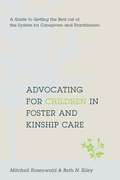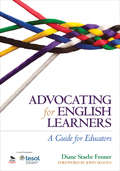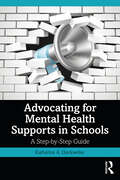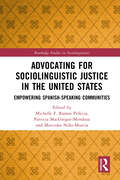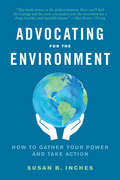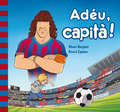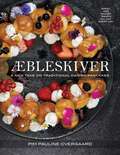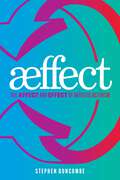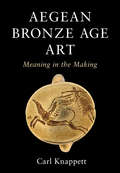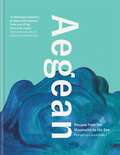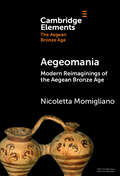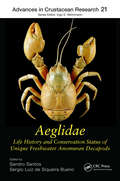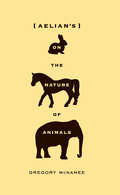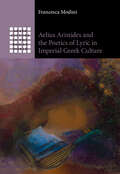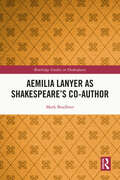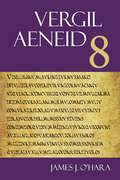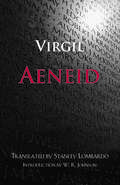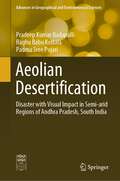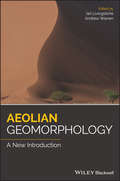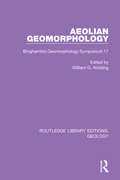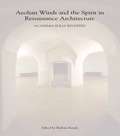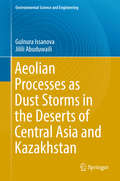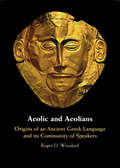- Table View
- List View
Advocating for Children in Foster and Kinship Care: A Guide to Getting the Best out of the System for Caregivers and Practitioners
by Mitchell Rosenwald Beth RileyThis book is the first to provide strategies for effective advocacy and placement within the foster care and kinship care systems. It also takes a rare look at the dynamics of the foster and kinship relationship, not just among children and the agency workers and service providers who intervene on their behalf, but also between children and those who take in and care for them as permanency develops. Drawing on their experience interacting with and writing about the institution of foster care, Mitchell Rosenwald and Beth N. Riley have composed a unique text that helps practitioners, foster parents, and relative caregivers realize successful transitions for youth, especially considering the traumas these children may suffer both before and after placement.Advocating for a child's best interests must begin early and remain consistent throughout assignment and adjustment. For practitioners, Rosenwald and Riley emphasize the best techniques for assessing a family's capabilities and for guiding families through the challenges of foster care. Part one details the steps potential foster parents and kinship caregivers must take, with the assistance of practitioners, to prepare themselves for placement. Part two describes tactics for successful advocacy within the court system, social service agencies, schools, and the medical and mental health establishments. Part three describes how to lobby for change at the agency and legislative levels, as well as within a given community. The authors illustrate recommendations through real-life scenarios and devote an entire chapter to brokering positive partnerships among practitioners, families, and other teams working to protect and transition children.
Advocating for English Learners: A Guide for Educators
by Diane Staehr FennerEmbrace the future by ensuring English Learners have a voice in school. English Learners (ELs) are the fastest-growing segment of the K–12 population. Therefore, educators must provide a voice for their needs. This book demystifies the techniques of advocacy for ELs, including: A shared sense of responsibility for EL success–Providing tools that every educator can use to ensure that ELs are effectively served An overview for administrators–Influencing policy and fostering a culture that meets EL needs Advocacy for ELs’ success beyond Grade 12–Equipping ELs for life after graduation, from higher education to career decisions
Advocating for Mental Health Supports in Schools: A Step-by-Step Guide
by Katherine A. DockweilerAdvocating for Mental Health Supports in Schools shows readers how to advocate for, and achieve, more mental health supports in schools. This timely book takes an actionable stance on the mental health issues schools are facing today, offering concrete strategies on how to advocate and what to advocate for. It contains model policy examples and expert advice from policy makers and practitioners across the country who are leaders in advocacy work. The book is divided into three sections. "Advocacy Truths" orients the reader as to what advocacy is and how to do it. "Policy Making" breaks down the complexity of the policy making process using simple terms and language, making it feel accessible and feasible. Finally, "Levels in Action" provides examples of federal, state, and local policy options to increase school-based mental health supports in schools. This section also outlines the ARTERY Pipeline Framework, showing readers how to systemically create workforce solutions to successfully recruit, train, and retain more school-based mental health professionals. Within this guide, educators; school-based mental health professionals; graduate students in school psychology, counseling, and social work; school board members; policy makers; families and others will find concrete solutions to incorporate into their advocacy work at all levels of policy making.
Advocating for Sociolinguistic Justice in the United States: Empowering Spanish-speaking Communities (Routledge Studies in Sociolinguistics)
by Mercedes Niño-Murcia Pellicia, Michelle F. Ramos Patricia MacGregor-MendozaThis collection focuses on social awareness and critical language awareness with the goal of enlightening and empowering multilingual and multicultural communities across the U.S.Each chapter brings to light the trauma, gaps in services and misguided societal perceptions that adversely impact communities whose linguistic and cultural background and/or status as migrants place them in vulnerable situations. In doing so, the authors and editors demonstrate how an increased awareness of diverse communities’ linguistic and cultural wealth can be leveraged to build strength and resilience in order to overcome physical, verbal or symbolic violence and provide remedies for inequities in educational, medical, and legal contexts.Showcasing discussions of the intersectionality and contexts in which language, power, migration, and the cultural funds of knowledge of minoritized communities interact, this volume will be of interest to students, scholars, and educators in sociolinguistics, applied linguistics, and language education.
Advocating for the Environment: How to Gather Your Power and Take Action
by Susan InchesAn accessible, solutions-oriented guide for addressing the earth's environmental crisis and enacting meaningful changeWhat can we as ordinary citizens do about climate change?" While countless environmental books focus on the causes of our current crisis, Advocating for the Environment is one of the first to focus on advocacy and policy-based solutions, arming readers with the tools they need to take action and enact change. In Part I, environmental policy expert Susan Inches discusses storytelling, empathy, mindset, and how effective communication can help us collaborate with others, even those with opposing views. Part II focuses on practical skills like coalition building, media relations, communication strategy, and navigating political and bureaucratic obstacles that block large-scale legislation. The book also includes case studies, research, and templates to deepen learning. Professors and teachers, students, legislators, environmental clubs, and church groups will also find useful ideas and strategies on every page.
Adéu Capità!
by Ricard Zaplana Ruiz Oliveri BenjamiUn homenatge a un magnífic jugador i millor persona que sempre ha despertat l'afecte i l'admiració de tots els culés Podem mesurar l'èxit sumant gols, medalles, copes, campionats, premis... I els nostres triomfs potser seran molts. Podem mesurar l'èxit valorant l'esforç, la lluita, la superació, el coratge en cada moment... I els nostres triomfs seran grans. Gràcies capità. Per emocionar-nos en cada partit donant-ho tot i més, per compartir amb nosaltres la il·lusió d'un esport i d'un club, per fer-nos somiar, per ensenyar-nos el valor de l'amistat i del compromís. Sempre seràs el gran capità.
Aebleskiver: A New Take on Traditional Danish Pancakes
by Pim Pauline OvergaardÆbleskiver presents 70 delicious twists on the classic Danish pancake, offering everything from sweet delights to savory bites. These versatile treats are ideal for any meal, especially a brunch gathering with family and friends."Even if you have never eaten æbleskiver, these little round Danish pancakes may be your new favorite food, thanks to Pim Pauline Overgaard&’s tempting, gorgeous cookbook. [...] Æbelskiver is a creative, playful, and lively cookbook that expands the possibilities of working with the cute pancake-esque pastries." —Foreword Reviews "With an enticing collection of recipes and beautiful photography throughout, Æbleskiver will inspire both novice cooks and seasoned chefs alike to explore the rich tapestry of Danish flavors through Denmark&’s favorite treat." —Pastry Arts magazine Discover the world of æbleskiver, the beloved sphere-shaped Danish pancakes traditionally savored during the holidays and for special celebrations. In this contemporary twist, more than 70 recipes transform these sweet delights to everyday fare. Home cooks will love the variety of dishes, including: • Savory spins on the Danish delicacy, ranging from Ricotta Salata Æbleskiver with Grilled Corn and Fresh Herb Spread to Saffron Rice Æbleskiver a la Paella. • Special desserts for any sweet tooth, including Almond Æbleskiverwith Warm Mixed Berry Compote and White Chocolate Hazelnut Æbleskiver with Sweet Beet Ice Cream and Candied Beet Chips. • Mouth-watering sub-recipes for sauces, jams, glazes, and other accompaniments that can take a humble æbleskiver to the heights of sophistication. These 70 recipes deliver fresh flavor combinations in addition to gluten-free and vegan variations for many of the recipes. And the vivid photography by the author will have you savoring the beauty and versatility of æbleskiver.
Aeffect: The Affect and Effect of Artistic Activism
by Stephen DuncombeThe first book to seriously identify how artistic activism works and how to make it work betterThe past decade has seen an explosion in the hybrid practice of “artistic activism,” as artists have turned toward activism to make their work more socially impactful and activists have adopted techniques and perspectives from the arts to make their interventions more creative. Yet questions haunt the practice: Does artistic activism work aesthetically? Does it work politically? And what does “working” even mean when one combines art and activism? In Æffect, author Stephen Duncombe sets out to address these questions at the heart of the field of artistic activism.Written by the co-founder and current Research Director of the internationally recognized Center for Artistic Activism, Æffect draws on Duncombe’s more than twenty-five years of experience in the field and one hundred in-depth interviews with artistic activists worldwide. More than a mere academic exercise, the theory, research, and tools in this book lay the groundwork for artistic activists to evaluate and strengthen their practice and to create better projects. The exploration of good artistic activism is grounded in three sets of concerns. 1) Change: Upon what theories of change is artistic activism based? 2) Intention: What do we hope and expect artistic activism to do, and how does it do this? 3) Evaluation: What actually happens as the result of an artistic activist intervention? Can it be measured?Æffect is rich with examples that demonstrate successful artistic activism, including Undocubus, an old bus painted “No Fear” across its side that was driven cross-country by a group of undocumented immigrant activists; Journal Rappé, a video show created by Senegalese rappers who created long-form investigative reports by rapping the current news in French and Wolof; and War on Smog, a staged a public performance piece by artistic activists in the city of Chongqing in Southwest China. Scannable QR codes are included to provide tools that help readers assess the æffect of their artistic activism.
Aegean Bronze Age Art: Meaning in the Making
by Carl KnappettHow do we interpret ancient art created before written texts? Scholars usually put ancient art into conversation with ancient texts in order to interpret its meaning. But for earlier periods without texts, such as in the Bronze Age Aegean, this method is redundant. Using cutting-edge theory from art history, archaeology, and anthropology, Carl Knappett offers a new approach to this problem by identifying distinct actions - such as modelling, combining, and imprinting - whereby meaning is scaffolded through the materials themselves. By showing how these actions work in the context of specific bodies of material, Knappett brings to life the fascinating art of Minoan Crete and surrounding areas in novel ways. With a special focus on how creativity manifests itself in these processes, he makes an argument for not just how creativity emerges through specific material engagements but also why creativity might be especially valued at particular moments.
Aegean: Recipes from the Mountains to the Sea
by Marianna Leivaditaki'A delicious evocation of place and memory from one of my favourite cooks.' Allan Jenkins, Editor of Observer Food Monthly'This book is so much more than a cookbook, it's a love song to a very special place and we are lucky to have the brilliant Marianna as our guide.' Itamar Srulovich, co-founder of Honey & Co.'I want to make everything in this beautiful book. An absolute treasure.' Rosie Birkett, author of The Joyful Home CookWith photography from Elena Heatherwick, the Fortnum & Mason Food and Drink Photographer of the Year 2020Marianna Leivaditaki is a natural storyteller. She grew up in Chania, on the Greek island of Crete, and spent her childhood helping out in the family-run taverna. After school, she carried around her blue notebook, writing downall the recipes she would like to cook, helped by the Greek grannies' kitchen wisdom. Marianna's love for the food of her heritage flows off every page, but she also has a contemporary take on it. As head chef of Morito in Hackney, she has championed high-quality ingredients, presenting them in simple, stunning sharing plates, and has been critically acclaimed for doing so.These inspirational recipes derive from the SEA, the LAND and the MOUNTAINS. We all know the health benefits of a Mediterranean diet, rich in olive oil, fresh vegetables and fruit, nuts, fish and whole grains, as well as the importanceof how you eat and appreciate your food. Marianna offers achievable, yet delicious dishes celebrating seasonal, fresh food that you can take time to enjoy with friends and family.
Aegeomania: Modern Reimaginings of the Aegean Bronze Age (Elements in The Aegean Bronze Age)
by Nicoletta MomiglianoThis Element provides an overview of Aegeomania: the fascination, sometimes bordering on the obsession, with the Aegean Bronze Age, which manifests itself in the uses of Aegean Bronze Age material culture to create something new in literature, the visual and performing arts, and many other cultural practices. It discusses the role that Aegeomania can play in our understanding of the Aegean Bronze Age and illustrates this with examples from the 1870s to the present, which include, among many others, poems by Emma Lazarus, Salvatore Quasimodo, and Giorgos Seferis; novels by Kristmann Gudmundsson, Mary Renault, Don DeLillo, Zeruya Shalev, and Sally Rooney; Freudian psychoanalysis; sculptures by Henry Moore and Pablo Picasso; music by Harrison Birtwistle and the rock band Giant Squid; films by Robert Wise and Wolfang Petersen; elegant textiles and garments created by Josef Frank and Karl Lagerfeld. This title is also available as Open Access on Cambridge Core.
Aeglidae: Life History and Conservation Status of Unique Freshwater Anomuran Decapods (Advances in Crustacean Research #19)
by Sandro Santos Sergio Luiz de Siqueria BuenoAeglidae focuses on these unique crustaceans who are endemic to South America. The book is the first to summarize the diverse aspects of the Aeglidae, whose taxonomic features and phylogenetic relationships, evolutionary history and biogeographical background, biological characteristics, and current conservation awareness make them stand out among all other decapods. Addresses the morphology, taxonomy, and phylogenetics that characterize the Aegla and their relationship to other decapod taxa Provides in-depth treatment of the evolutionary history, biogeography, reproduction, developmental biology, and the life cycle of the Aeglidae Discusses their physiology, ecology and behavior, including physiological mechanisms associated with freshwater adaptation, population dynamics, trophic ecology, agonistic and non-agonistic behavior Covers the current conservation status of all known species of aeglids, major threats to them, the use of aeglids as flagships or umbrella species, and conservation action planning Edited by internationally distinguished leaders in this field. This will be an important reference not only for carcinologists working with this family of decapods, but also readers interested in the evolution, biogeography, taxonomy, phylogenetics, physiology, and reproductive ecology.
Aelian's On the Nature of Animals
by Gregory McnameeNot much can be said with certainty about the life of Claudius Aelianus, known to us as Aelian. He was born sometime between A.D. 165 and 170 in the hill town of Praeneste, what is now Palestrina, about twenty-five miles from Rome, Italy. He grew up speaking that town's version of Latin, a dialect that other speakers of the language seem to have found curious, but-somewhat unusually for his generation, though not for Romans of earlier times-he preferred to communicate in Greek. Trained by a sophist named Pausanias of Caesarea, Aelian was known in his time for a work called Indictment of the Effeminate, an attack on the recently deceased emperor Marcus Aurelius Antoninus, who was nasty even by the standards of Imperial Rome. He was also fond of making almanac-like collections, only fragments of which survive, devoted to odd topics such as manifestations of the divine and the workings of the supernatural.His De Natura Animalium (On the Nature of Animals) has a similar patchwork quality, but it was esteemed enough in his time to survive more or less whole, and it is about all that we know of Aelian's work today. A mostly randomly ordered collection of stories that he found interesting enough to relate about animals-whether or not he believed them-Aelian's book constitutes an early encyclopedia of animal behavior, affording unparalleled insight into what ancient Romans knew about and thought about animals-and, of particular interest to modern scholars, about animal minds.If the science is sometimes sketchy, the facts often fanciful, and the history sometimes suspect, it is clear enough that Aelian had a fine time assembling the material, which can be said, in the most general terms, to support the notion of a kind of intelligence in nature and that extends human qualities, for good and bad, to animals. His stories, which extend across the known world of Aelian's time, tend to be brief and to the point, and many return to a trenchant question: If animals can respect their elders and live honorably within their own tribes, why must humans be so appallingly awful?Aelian is as brisk, as entertaining, and as scholarly a writer as Pliny, the much better known Roman natural historian. That he is not better known is simply an accident: he has not been widely translated into English, or indeed any European language. This selection from his work will introduce readers to a lively mind and a witty writer who has much to tell us.
Aelian's On the Nature of Animals
by Gregory McnameeNot much can be said with certainty about the life of Claudius Aelianus, known to us as Aelian. He was born sometime between A.D. 165 and 170 in the hill town of Praeneste, what is now Palestrina, about twenty-five miles from Rome, Italy. He grew up speaking that town's version of Latin, a dialect that other speakers of the language seem to have found curious, but-somewhat unusually for his generation, though not for Romans of earlier times-he preferred to communicate in Greek. Trained by a sophist named Pausanias of Caesarea, Aelian was known in his time for a work called Indictment of the Effeminate, an attack on the recently deceased emperor Marcus Aurelius Antoninus, who was nasty even by the standards of Imperial Rome. He was also fond of making almanac-like collections, only fragments of which survive, devoted to odd topics such as manifestations of the divine and the workings of the supernatural.His De Natura Animalium (On the Nature of Animals) has a similar patchwork quality, but it was esteemed enough in his time to survive more or less whole, and it is about all that we know of Aelian's work today. A mostly randomly ordered collection of stories that he found interesting enough to relate about animals-whether or not he believed them-Aelian's book constitutes an early encyclopedia of animal behavior, affording unparalleled insight into what ancient Romans knew about and thought about animals-and, of particular interest to modern scholars, about animal minds.If the science is sometimes sketchy, the facts often fanciful, and the history sometimes suspect, it is clear enough that Aelian had a fine time assembling the material, which can be said, in the most general terms, to support the notion of a kind of intelligence in nature and that extends human qualities, for good and bad, to animals. His stories, which extend across the known world of Aelian's time, tend to be brief and to the point, and many return to a trenchant question: If animals can respect their elders and live honorably within their own tribes, why must humans be so appallingly awful?Aelian is as brisk, as entertaining, and as scholarly a writer as Pliny, the much better known Roman natural historian. That he is not better known is simply an accident: he has not been widely translated into English, or indeed any European language. This selection from his work will introduce readers to a lively mind and a witty writer who has much to tell us.
Aelius Aristides and the Poetics of Lyric in Imperial Greek Culture (Greek Culture in the Roman World)
by Francesca ModiniThis book is the first study of the persistence and significance of ancient lyric in imperial Greek culture. Redefining lyric reception as a phenomenon ranging from textual engagement with ancient poems to the appropriation of song traditions, Francesca Modini reconsiders the view of imperial culture (paideia) as dominated by Homer and fifth-century Attic literature. She argues that textual knowledge of lyric allowed imperial writers to show a more sophisticated level of paideia, and her analysis further reveals how lyric traditions mobilised distinctive discourses of self-fashioning, local identity, community-making and power crucial for Greeks under Rome. This is most evident in the works of Aelius Aristides, who reconfigured ancient lyric to shape his rhetorical persona and enhance his speeches to imperial communities. Exploring Aristides' lyric poetics also changes how we interpret his reconstruction of the classical tradition and his involvement in the complex politics of the Empire.
Aemilia Lanyer as Shakespeare’s Co-Author (Routledge Studies in Shakespeare)
by Mark BradbeerThis book presents original material which indicates that Aemilia Lanyer – female writer, feminist, and Shakespeare contemporary – is Shakespeare’s hidden and arguably most significant co-author. Once dismissed as the mere paramour of Shakespeare’s patron, Lord Hunsdon, she is demonstrated to be a most articulate forerunner of #MeToo fury. Building on previous research into the authorship of Shakespeare’s works, Bradbeer offers evidence in the form of three case studies which signal Aemilia’s collaboration with Shakespeare. The first case study matches the works of "George Wilkins" – who is currently credited as the co-author of the feminist Shakespeare play Pericles (1608) – with Aemilia Lanyer’s writing style, education, feminism and knowledge of Lord Hunsdon’s secret sexual life. The second case-study recognizes Titus Andronicus (1594), a play containing the characters Aemilius and Bassianus, to be a revision of the suppressed play Titus and Vespasian (1592), as authored by the unmarried pregnant Aemilia Bassano, as she then was. Lastly, it is argued that Shakespeare’s clowns, Bottom, Launce, Malvolio, Dromio, Dogberry, Jaques, and Moth, arise in her deeply personal war with the misogynist Thomas Nashe. Each case study reveals new aspects of Lanyer’s feminist activism and involvement in Shakespeare’s work, and allows for a deeper analysis and appreciation of the plays. This research will prove provocative to students and scholars of Shakespeare studies, English literature, literary history, and gender studies.
Aeneid 8 (The Focus Vergil Aeneid Commentaries)
by Vergil Mr James J. O'Hara Randall GanibanVergil: Aeneid 8 is part of a new series of commentaries on the Aeneid. Each volume adapts with extensive revisions and additions the commentaries of T. E. Page (1884, 1900), and is edited by a scholar of Roman epic. The present volume offers the Latin text of Book 8 along with maps, extensive notes, and commentary designed to meet the needs of intermediate students of Latin. A two-volume edition of the entire Aeneid designed to meet the needs of advanced students will be derived from the series.
Aeneid: Books Ix. , X (classic Reprint) (Hackett Classics)
by VirgilLong a master of the crafts of Homeric translation and of rhapsodic performance, Stanley Lombardo now turns to the quintessential epic of Roman antiquity, a work with deep roots in the Homeric tradition. With characteristic virtuosity, he delivers a rendering of the Aeneid as compelling as his groundbreaking translations of the Iliad and the Odyssey, yet one that--like the Aeneid itself--conveys a unique epic sensibility and a haunting artistry all its own.W. R. Johnson's Introduction makes an ideal companion to the translation, offering brilliant insight into the legend of Aeneas; the contrasting roles of the gods, fate, and fortune in Homeric versus Virgilian epic; the character of Aeneas as both wanderer and warrior; Aeneas' relationship to both his enemy Turnus and his lover Dido; the theme of doomed youths in the epic; and Virgil's relationship to the brutal history of Rome that he memorializes in his poem.A map, a Glossary of Names, a Translator's Preface, and Suggestions for Further Reading are also included.
Aenesidemus of Cnossus
by Roberto PolitoThis book provides the first edition of all testimonia on the Sceptic philosopher Aenesidemus of Cnossus, deemed to be the source of Sextus Empiricus, the main representative for us of ancient Scepticism. It will be an essential reference work for all those scholars and students dealing with the history of ancient Scepticism. It provides an extensive philosophical and historical commentary, and throws light on a series of questions concerning the philosophy of the late Academy, Stoic Heracliteanism, and the interaction between medicine and philosophy in the late Hellenistic era.
Aeolian Desertification: Disaster with Visual Impact in Semi-arid Regions of Andhra Pradesh, South India (Advances in Geographical and Environmental Sciences)
by Pradeep Kumar Badapalli Raghu Babu Kottala Padma Sree PujariThis book summarizes contemporary research on land degradation, desertification, and how such issues relate to socioeconomic growth in developing countries. With a focus on local and regional levels, the book offers an in-depth analysis of aeolian action as a physical process, causes of land degradation, and desertification. The causes and effects of land degradation were investigated by utilizing multiscale and multidisciplinary methodologies, merging spatial socioeconomic data with remote sensing data, and using multiple levels and disciplinary approaches. The book also describes how to combine GIS with cutting-edge technologies such as remote sensing, geostatistics, scanning electron microscopy (SEM) and energy-dispersive X-ray (EDAX) analysis, and analytical hierarchy approaches, among others. Included is a thorough case study of the unusual but understudied semi-arid Anantapur district in Andhra Pradesh, South India. This book encourages the participation of all socioeconomic groups in decision-making and assists authorities and planners in developing suitable plans for the sustainable agricultural growth of an area. The book is an invaluable resource to comprehend and resolve issues about sustainable environmental planning and management.
Aeolian Geomorphology: A New Introduction (Zeitschrift Für Geomorphologie, Supplementbände Ser.)
by Ian Livingstone Andrew WarrenA revised introduction to aeolian geomorphology written by noted experts in the field The new, revised and updated edition of Aeolian Geomorphology offers a concise and highly accessible introduction to the subject. The text covers the topics of deserts and coastlines, as well as periglacial and planetary landforms. The authors review the range of aeolian characteristics that include soil erosion and its consequences, continental scale dust storms, sand dunes and loess. Aeolian Geomorphology explores the importance of aeolian processes in the past, and the application of knowledge about aeolian geomorphology in environmental management. The new edition includes contributions from eighteen experts from four continents. All the chapters demonstrate huge advances in observation, measurement and mathematical modelling. For example, the chapter on sand seas shows the impact of greatly enhanced and accessible remote sensing and the chapter on active dunes clearly demonstrates the impact of improvements in field techniques. Other examples reveal the power of greatly improved laboratory techniques. This important text: Offers a comprehensive review of aeolian geomorphology Contains contributions from an international panel of eighteen experts in the field Includes the results of the most recent research on the topic Filled with illustrative examples that demonstrate the advances in laboratory approaches Written for students and professionals in the field, Aeolian Geomorphology provides a comprehensive introduction to the topic in twelve new chapters with contributions from noted experts in the field.
Aeolian Geomorphology: Binghamton Geomorphology Symposium 17 (Routledge Library Editions: Geology #2)
by William G. NicklingThis book, first published in 1986, stems from the 1986 Binghamton Geomorphology Symposium. The topic was chosen because of the advances in the study of aeolian processes and landforms, particularly in the area of desertification, and the papers collected here clearly indicate that their study is not constrained by discipline boundaries but are of interest to geologists, physical geographers, soil scientists, meteorologists and engineers.
Aeolian Winds and the Spirit in Renaissance Architecture: Academia Eolia Revisited
by Barbara KendaWritten by scholars of international stature, Aeolian Winds and the Spirit in Renaissance Architecture presents studies of Renaissance pneumatology exploring the relationship between architecture and the disciplines of art and science. One of the principle goals of Renaissance architects was to augment the powers of pneuma so as to foster the art of well-being. Central to the study of pneumatic architecture are six Italian villas connected together by a ventilating system of caves and tunnels, including Eolia, in which Trento established an academic circle of scholars that included Palladio, Tazzo and Ruzzante. Picking up on current interest in environmental issues, Aeolian Winds and the Spirit in Renaissance Architecture reintroduces Renaissance perspectives on the key relationships in environmental issues between architecture and art and science. This beautifully illustrated and unprecedented study will illuminate the studies of any architecture or Renaissance student or scholar.
Aeolian proceses as Dust Storms in the Deserts of Central Asia and Kazakhstan (Environmental Science and Engineering)
by Gulnura Issanova Jilili AbuduwailiThis book highlights the aeolian processes in the desert zone of Kazakhstan and analyzes the current status of dust and sand storms in Central Asia and Kazakhstan. It also highlights the analyses, dynamics and long-term observations of storms on the basis of numerous cartographic materials and satellite images. Dust/sand storms are a common and important phenomenon in the arid and semi-arid regions of Kazakhstan, especially in its southern parts, where areas are covered by a great variety of deserts and offer a significant source of mineral and salt aerosols. The deserts of Kazakhstan mostly cover lowlands and extend from the eastern coast of the Caspian Sea to the piedmonts of the Tien-Shan Mountain. In Kazakhstan, desertification processes due to wind erosion in the form of dust/sand storms were observed in semi-desert and desert landscapes.
Aeolic and Aeolians: Origins of an Ancient Greek Language and its Community of Speakers
by Roger D. WoodardAeolic and Aeolians explores the origin of an ancient Greek language and the beginnings and evolution of the community of its speakers – the Aeolians. Roger Woodard argues that the starting point for both is situated in Asia Minor during the period of the Late Bronze Age, and that the ancestral Aeolic speech community can be identified with the Mycenaean peoples of Anatolia called the Ahhiyawans in Hittite records. These Bronze-Age Asian Greeks would intermarry with local Luvian peoples of western Anatolia, and the Aeolian language and identity – an identity encoded in myth-emerged from the intermixing of the two societies. Aeolian myths are central to Woodard's ground-breaking investigations presented in this volume. He demonstrates how assemblages of mythic components, what Lévi-Strauss called bricolage, enabled early Aeolians to give intellectual expression to their distinctive Greek identity. With the collapse of Bronze-Age societies in Mycenaean Greece, some of the early Aeolians of Anatolia would migrate to Europe, introducing their language and myths into Hellas.
